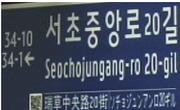In this study, two methods are proposed for the transverse confinement of columns; 1) The one is the confinement method using the FRP. 2) The other is the confinement method using interlocking reinforcement, etc. for oblong cross-section. Test columns...
http://chineseinput.net/에서 pinyin(병음)방식으로 중국어를 변환할 수 있습니다.
변환된 중국어를 복사하여 사용하시면 됩니다.
- 中文 을 입력하시려면 zhongwen을 입력하시고 space를누르시면됩니다.
- 北京 을 입력하시려면 beijing을 입력하시고 space를 누르시면 됩니다.
철근 콘크리트 교각의 심부구속방법 개선 연구, 2002(연구) : (A Study on the Confinement Method of Reinforced Concrete Bridge Piers)
한글로보기https://www.riss.kr/link?id=G3630363
- 저자
- 발행기관
-
발행연도
2002년
-
작성언어
Korean
- 주제어
-
자료형태
한국건설기술연구원
-
수록면
328
-
0
상세조회 -
0
다운로드
부가정보
다국어 초록 (Multilingual Abstract)
In this study, two methods are proposed for the transverse confinement of columns; 1) The one is the confinement method using the FRP. 2) The other is the confinement method using interlocking reinforcement, etc. for oblong cross-section. Test columns were made using FRP(4,400TEX@7) whose strength is the same as the transverse steel bar. They showed lower seismic performance than the specimen with spiral reinforcing steel, and yet satisfied the required response modification factor(R), 3, which is specified for the single column in Korean bridge design specification. It was also found that additional test specimens with FRP of 4,400TEX@14 and 4,400TEX@21 significantly increased the displacement ductility factor by about 30% compared to the initial test specimens with FRP of 4,400TEX@7. FRP can be substituted for conventional reinforcing steel. The experimental study for oblong cross-section was carried out by the column test in weak axis and strong axis. The column specimens had 5 types of transverse steel details, such as interlocking spirals(IS), interlocking circular hoop ties(IC), hooked or unhooked U-type hoops(HC, LC), and rectangular ties(RT). The oblong column with IS, with IC, and HC showed better seismic performance than the rectangular columns with RT. Interlocking circular hoop ties, which use the same circular hoop ties as the circular cross-section, considerably reduce the amount of transverse reinforcement than the rectangular ties by about 50%. Connection of rebars can also be simplified. It can be the alternative for oblong section with improved workability and cost-efficiency.
국문 초록 (Abstract)
본 연구에서는 (1) 원형교각의 횡방향 구속철근의 시공성을 개선하기 위해서 기존의 철근보다 가볍고, 부식이 되지 않으며, 인장강도가 크고, 성형성이 좋은 신소재(FRP)를 이용하여 심부를 ...
본 연구에서는 (1) 원형교각의 횡방향 구속철근의 시공성을 개선하기 위해서 기존의 철근보다 가볍고, 부식이 되지 않으며, 인장강도가 크고, 성형성이 좋은 신소재(FRP)를 이용하여 심부를 구속할 수 있는 방안과 (2) 장방형(Oblong) 교각의 장점을 활용하면서도 시공조건을 개선시켜주고, 철근량이 감소될 수 있는 설계 및 시공방법을 도출하기 위해, 기존의 사각형 교각의 횡방향 구속 방법과 다른 형태의 배근인 인터락킹(Interlocking) 방법 등을 적용한 원장방형 교각의 내진성능에 대해서 검토하고자 하였다. 먼저, FRP를 횡방향 보강근으로 사용한 교각 시험체의 경우, 횡방향 보강철근의 항복하중에 상당하는 FRP 배근양으로 횡구속을 하였을 때는 철근을 사용한 시험체의 성능에 미치지 못하였으나, 국내도로교설계기준에서 제시하고 있는 연성능력을 보유하고 있는 것으로 나타났다. 섬유량을 2배 및 3배 증가한 FRP로 구속시켜 실험을 수행한 결과, 평균 30% 정도의 연성능력 증진 효과를 나타내 FRP 횡보강근의 가능성을 확인하였다. 장방형 형태의 교각 즉, 기존 형태의 직사각형 단면교각과 이와 동일한 단면적을 갖지만 횡방향 구속철근의 배근 방법이 다른 네 가지의 원장방형 교각에 대해서 성능실험을 실시한 결과, 결합 나선철근 실험체(IS), 결합 원형띠철근 실험체(IC), 갈고리가 있는 U형 띠철근 실험체(HC)는 기준 실험체인 사각형 후프띠철근 실험체(RT)에 비하여 우수한 내진성능을 나타냈다. 특히, 결합 원형띠철근을 사용한 시험체(IC)는 직사각형(RT)보다 작은 철근량으로 동일한 내진성능을 발휘할 수 있고, 심부구속배근시 작업공간을 확보하면서도 띠철근의 연결부를 중심부에 둘 수 있어 커풀러나 용접이음없이 겹이음 또는 갈고리 이음으로 시공이 가능하므로 경제성과 시공성이 향상될 것으로 기대된다.
목차 (Table of Contents)
- 제1장 서론
- 1.1 연구배경 및 목적
- 1.2 연구 내용
- 1.2.1 신소재(FRP)를 이용한 교각 심부구속방법
- 1.2.2 장방형 교각의 심부구속방법
- 제1장 서론
- 1.1 연구배경 및 목적
- 1.2 연구 내용
- 1.2.1 신소재(FRP)를 이용한 교각 심부구속방법
- 1.2.2 장방형 교각의 심부구속방법
- 제2장 국내·외 연구동향
- 2.1 국외 연구동향
- 2.1.1 개요
- 2.1.2 F. E. Richart. A. Brandtzaeg, and R. L. Brown(1928)
- 2.1.3 S. H. Ahmad and S. P. Shah(1982)
- 2.1.4 B. D. Scott, R. Park, and M. J. N. Priestley(1982)
- 2.1.5 Muguruma, H. and Watanabe, F.(1983)
- 2.1.6 Uzumeri, S. M., Basset, R.(1987)
- 2.1.7 Yook-Kong Yong, Malakah G. Nour, Edward G. Nawy(1988)
- 2.1.8 Yuk Hon Chai, M.J. Nigel Priestley, Frieder Seible(1991)
- 2.1.9 Yuk-Lung Wong, T. Paulay, M.J. Nigel Priestley(1993)
- 2.1.10 D. Cusson and P. Paultre(1994)
- 2.1.11 Hussaini, A. A., Regan, P. E., Xue, H-Y., Ramandane, K-E.(1993)
- 2.1.12 Shamim A. Sheikh and Murat T. Toklucu(1993년)
- 2.1.13 Shamim A. Sheikh and Shafik S. Khoury(1993)
- 2.1.14 S. P. Shah, D. C. Jansen(1994)
- 2.1.15 H. Tanaka and R. Park(1993)
- 2.1.16 David I. McLen, Grant C. Buckingham(1994)
- 2.1.17 H. Saadatmanesh, M.R. Ehsani, Limin Jin(1996)
- 2.1.18 M. J. Nigel Priestley and Gianmario Benzoni(1996)
- 2.1.19 Martin S. Williams, Isabelle Villemure, Robert G. Sexsmith(1997)
- 2.1.20 Shamim A. Sheikh, Shafik S. Khoury(1997)
- 2.1.21 Hamid Saadatmanesh, Mohammad R. Ehsani, and Limin Jin(1997)
- 2.1.22 P. Srinivasa Rao, B. Sivarama Sarma, N. Lakshmanan, F. Stangenberg(1998)
- 2.1.23 Salim Razvi, Murat Saatcioglu(1999)
- 2.1.24 Nadim I. Wehbe, M. Saiid Saiidi, and David H. Sanders(1999)
- 2.1.25 Y. L. Mo, and S. J. Wang(2000)
- 2.1.26 Yoshiharu MIZUGAMI. Yoshinori IGASE(2000)
- 2.1.27 Y.-K. Yeh, Y.L. Mo, C.Y. Yang(2001)
- 2.1.28 Yung C. Wang and Jos\acute{e} I. Restrepo(2001)
- 2.1.29 Dawn E. Lehman, Sharon E. Gookin, Adrian M. Nacamuli, and Jack P. Moehle(2001)
- 2.1.30 Hisham M.Nada, David H. Sanders and M. Saiidi(2002)
- 2.2 국내연구동향
- 2.2.1 개요
- 2.2.2 원형띠철근 교각실험(중앙대, 건설교통부, 1999)
- 2.2.3 원형중공 교각실험(중앙대, 지진공학센타, 1999)
- 2.2.4 사각형 교각실험(영남대, 한국도로공사, 1999)
- 2.2.5 내진보강실험 - 원형교각(서울대, 지진공학회, 시설안전공단, 1999)
- 2.2.6 원형 철근 콘크리트 교각의 유사동적 실험(중앙대, 지진공학센타, 건설교통부, 1999)
- 2.2.7 나선철근 교각실험(영남대, 한국도로공사, 2000)
- 2.2.8 원형띠철근 교각실험(영남대, 한국도로공사, 2000)
- 2.2.9 원형띠철근 갈고리상세 실험(영남대, 한국도로공사, 2000)
- 2.2.10 2축휨 실험(서울대, 지진공학센타, BK21, 2000)
- 2.2.11 유리섬유 보강실험(중앙대, 지진공학센타, 2001)
- 2.2.12 휨-전단 실험(한국건설기술연구원, 2001)
- 2.2.13 실물 교각 실험(중앙대, 영남대, 한국도로공사, 2001)
- 2.2.14 실물 교각의 유사동적 실험(중앙대, 영남대, 한국도로공사, 2001)
- 2.2.15 섬유 보강된 휨-전단 교각의 실험(중앙대, 지진공학센타, 2002)
- 2.3 부재거동에 관한 문헌연구
- 2.3.1 반복하중을 받는 재료의 특성
- 2.3.2 횡철근의 역할
- 2.3.3 횡방향철근양의 효과
- 2.3.4 횡철근의 항복강도 효과
- 2.3.5 횡방향철근 상세의 효과
- 2.3.6 내진규정의 횡철근양에 관한 규준
- 2.3.7 주철근의 좌굴방지에 관한 횡철근의 간격규정
- 2.3.8 축력비의 효과
- 제3장 국내외 내진설계기준
- 3.1 일반 사항
- 3.2 도로교 내진설계기준
- 3.2.1 일반 사항
- 3.2.2 도로교 설계기준의 내진설계의 특징
- 3.3 미국의 설계기준
- 3.3.1 AASHTO의 내진설계 기준
- 3.3.2 ATC-32
- 3.4 일본의 설계기준
- 3.4.1 개요
- 3.4.2 내진설계의 기본 방침
- 3.4.3 내진설계시 고려하여야 할 하중
- 3.4.4 관성력
- 3.4.5 내진설계상의 지반 종류
- 3.4.6 설계진도
- 3.5 유럽의 설계기준
- 3.5.1 교량의 중요도에 따른 설계 지진
- 3.5.2 지반의 영향
- 3.5.3 응답스펙트럼
- 3.5.4 설계 기본 요건
- 3.5.5 설계 적용개념
- 3.5.6 설계 조건
- 3.5.7 내진해석
- 3.5.8 선형해석을 위한 거동계수
- 3.5.9 내진해석 방법
- 3.5.10 강성 검토규정(strength verification)
- 3.5.11 설계 하중검토
- 3.5.12 콘크리트 단면에 대한 강성 검토
- 3.5.13 상세설계규정
- 3.6 Inter-locking을 이용한 심부구속 방법에 관한 규준
- 3.6.1 CALTRANS
- 3.6.2 Eurocode 8 - Part 2
- 3.6.3 AASHTO
- 제4장 FRP를 이용한 교각의 심부구속방법
- 4.1 개요
- 4.2 FRP의 특성
- 4.3 로프형 FRP 횡방향 보강근을 이용한 교각 실험
- 4.3.1 로프형 FRP의 물성
- 4.3.2 시험체 제작
- 4.3.3 실험방법
- 4.3.4 실험결과
- 4.4 밴드형 FRP 횡방향 보강근을 이용한 교각 실험
- 4.4.1 밴드형 FRP의 물성
- 4.4.2 시험체 제작
- 4.4.3 실험결과
- 4.4.4 단면증가 밴드형 FRP
- 4.5 소결
- 제5장 장방형 교각의 심부구속방법
- 5.1 실험 개요
- 5.2 시험체 제작
- 5.2.1 시험체 단면 및 철근상세
- 5.2.2 약축 시험체
- 5.2.3 강축 시험체
- 5.2.4 재료강도
- 5.2.5 실험방법
- 5.3 약축방향 실험결과
- 5.3.1 파괴거동
- 5.3.2 하중-변위 이력곡선
- 5.3.3 하중-변위 포락곡선
- 5.3.4 항복변위
- 5.3.5 극한변위 및 최소극한변위
- 5.3.6 변위연성도 및 응답수정계수
- 5.3.7 축력비에 따른 횡력강도 및 최소극한변위
- 5.3.8 나선철근 결합부의 축방향철근 배치형태의 영향
- 5.3.9 에너지 소산능력
- 5.3.10 등가이력감쇠비 및 잔류변형
- 5.3.11 유효강성
- 5.4 강축방향 실험결과
- 5.4.1 파괴거동
- 5.4.2 하중-변위 이력곡선
- 5.4.3 하중-변위 포락곡선
- 5.4.4 항복변위 및 극한변위
- 5.4.5 변위연성도 및 응답수정계수
- 5.4.6 파괴모드 분석
- 5.4.7 에너지 소산능력 및 등가감쇠비
- 5.4.8 잔류변형 및 유효강성
- 5.5 소성힌지 구간 횡방향철근량의 비교
- 5.5.1 개요
- 5.5.2 소성힌지 구간 횡방향철근량의 산정
- 5.5.3 소성힌지 구간 횡방향철근량의 비교
- 5.5.4 횡방향 철근 상세별 장단점 비교
- 5.6 소결
- 제6장 결론 및 향후 추진계획
- 6.1 신소재(FRP)를 이용한 심부구속 방법
- 6.2 장방형 교각의 심부구속 방법 개선
- 6.3 향후 추진계획
- 참고문헌
- Appendix 1. 로프형 섬유재(FRP) 횡보강근 실험결과
- Appendix 2. 밴드형 섬유재(FRP) 횡보강근 실험결과
- Appendix 3. FRP 교각 시험체 균열도
- Appendix 4. 원장방형 교각 실험 및 파괴양상(약축)
- Appendix 5. 원장방형 교각 실험 및 파괴양상(강축)
- Appendix 6. 장방형 교각 시험체 균열도











